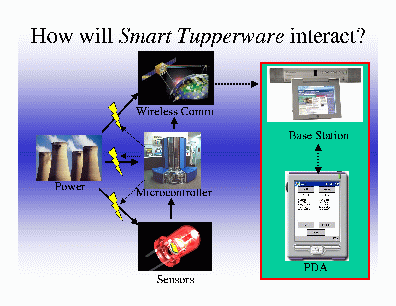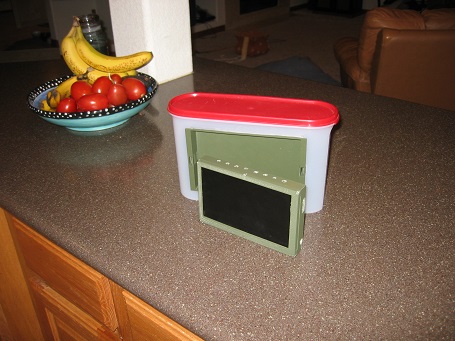Internet of Kitchen Things
This page represents nearly two decades of research and development on software and hardware technologies dedicated to the kitchen as the "nerve center" of the home. Smart Tupperware and its many variants represent efforts to move IoT beyond mere "remote control" (which has existed since the 1930s) to reducing the cognitive load of users. We acknoweldge the support of Tupperware Corp, Oregon Tool, the RoSe-HuB NSF I/UCRC (under grant NSF 1439717), and an NSF I-Corps grant (NSF 2023412).
Smart Tupperware(TM)
Did you ever go to the supermarket to buy milk and wonder, "While I'm here, do I need to buy cereal?" With Smart Tupperware and your trusty SmartPhone, you'll never have to wonder again! Students in the Collaborative Robotics Lab are creating "Smart Tupperware(TM)" in an effort to build infrastructure for the intelligent kitchen of the future.
Instrumented kitchen dry goods containers will monitor the state of fill and physical properties of the foods within. The state of fill will be maintained to keep the shopping list current on what items to buy. The physical properties will be used to allow the system to determine, on its own, what is contained in each container. Because the containers (and sensors) must be very cheap to be practical, the individual containers must be able to determine their contents with minimal sensory information. Enter the Community of Tupperware. The system will be web-aware and interconnected in order to determine the contents, relying on a vast array of information resources and other intelligent products within the home and beyond.
No endorsement by Tupperware Corp. is implied and the Tupperware trademark is the property of Tupperware Corp.

|
| Power is the primary constraint that drives computation, communication, and sensing. |
A practical shopping list app is the user's primary interface to the system. This list is automatically updated when food stuffs in the kitchen containers gets low.
We are also working with Prof. William Schuler to enhance Gesture Based Programming as an interaction paradigm for robotic assistance to the elderly in an intelligent kitchen.
Polymer Displays
We're currently working on Organic LEDs for a polymer display prototype with Prof. Sean Shaheen from the Physics Department. Out goal is to develop a printable, flexible display technology that can be deposited on the surface of a Tupperware container to provide programmable information. Below is a mock-up of what a conventional, rigid display might look like:

| 
|
Power and the ability to survive the microwave and dishwasher remain key design constraints. | |

| |
We are developing organic LEDs on flexible substrates. | |
Form + Function 4-D Printing of Entire Smart Products
This work has evolved into FF4DP and our work on printable form + printable sensing, computation and actuation. We are even working on Printable Software!See our webpage on Robotics Materials and Form + Function 4D Printing supported by the NSF under CNS 1726865).
IoKT Systems Publications
- S. Eom, H. Zhou, U. Kaur, R. M. Voyles and D. Kusuma, "TupperwareEarth: Bringing Intelligent User Assistance to the "Internet of Kitchen Things", in IEEE Internet of Things Journal, vol. 9, no. 15, pp. 13233-13249, 1 Aug.1, 2022, doi: 10.1109/JIOT.2022.3141112.
- S. Eom, R.M. Voyles and D. Kusuma, "Embedding Intelligence into Smart Tupperware Brings Internet of Things Home," in SPE Annual Technical Conference, Detroit, MI, Mar., 2019.
Energy Scavenging Publications
- R.A. Nawrocki, S. Shaheen, X. Yang and R.M. Voyles, "Towards an All-Polymer Robot for Search and Rescue," in IEEE Workshop on Safety, Security and Rescue Robots, Denver, CO, Nov., 2009.
- R.M. Voyles, J. Bae, "Smart Tupperware: An Example of Bluetooth Wireless Sensor Networks for Human Assistive Mechatronic Systems," in Proc. of the Intl. Conf. on Advanced Robotics, Jeju, Korea, Aug. 2007, pp. 449-454.
- S. Watters, T. Miller, P. Balachandran, W. Schuler, R. Voyles, "Exploiting a Sensed Environment to Improve Human-Agent Communication," in Proceedings of the 4th International Joint Conference on Autonomous Agents and Multi-Agent Systems, 2005.
- R. Goss, M. Genelin, S. Chhum, H. Gouwanda, G. Kaniamos, "Smart Tupperware Senior Design Final Report, Spring 2003"
- A. Engebretson, A. Brockman, C. Sanny, H. Le, M. Wenger, "Smart Tupperware Senior Design Final Report, Fall 2003"
Commercial Sources for Components
- Sensor and Actuator Source List
- Semiconductor Manufacturers
- Tupperware
- Socket Communications Bar code and RFID scanners (CF, SD, Bluetooth, wearable, etc)
- Symbol Technologies Bar Code scan engines and OEM components
- OKI Seminconductor BlueTooth modules (MK70 series)
- RF Monolithics Transceiver chips
- Intersil BlueTooth, 802.11 chips
- Silicon Wave BlueTooth radio and integrated software stack (UltimateBlue)
- IOSoft TCP/IP software and dev kits
- Ethernut Nut/OS for ATMega including TCP/IP protocol stack
- Vaisala Environmental sensors (ammonia, CO2, weather)
- IBM Alphaworks BlueTooth for Palm
- Open Source BlueTooth Core Open BlueTooth attempt
- Bluetags Embedded BlueTooth
- E-Pill "Beep 'N Tell" pill reminder, medication aids
- Robotic Aid for Medical Compliance at Home Fiorini and Nugent paper
- AARDEX Bibliography Medical compliance
- Food Spoilage Water Activity
- Food humidity KES
- Produce humidity KES
- Water Activity Cornell
Special Thanks
Thanks to Tupperware for donating a large variety of containers for our undergraduate Senior Design project.
Copyright: © 2003,2006,2010,2015,2016,2019 by Richard M. Voyles
rvoyles [at] purdue [dot] edu
